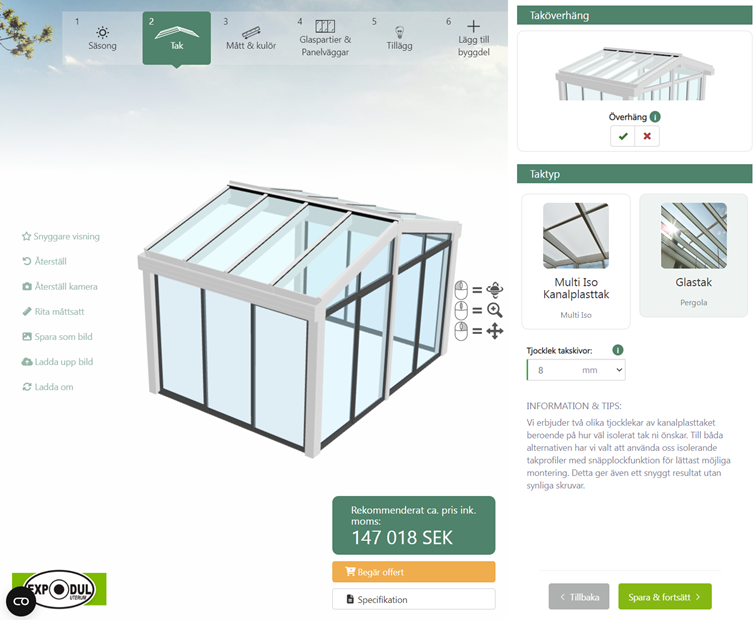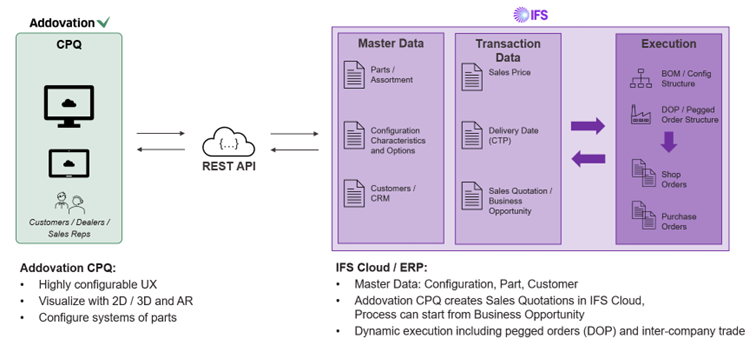CPQ as a Service
Last updated 2025-10-21
Use our solution to streamline the sales and quotation process for your businesses
Service Description
CPQ stands for Configure, Price, and Quote. The main components of CPQ are:
- Product Configuration: Allows sales teams to customize products to meet specific customer needs.
- Pricing: Ensures accurate pricing by considering various factors like discounts, promotions, and customer-specific pricing.
- Quoting: Generates professional and accurate quotes quickly, reducing the time it takes to close deals.
CPQ systems are particularly beneficial for companies with complex products or services, as they streamline the sales process, minimize errors, and improve customer satisfaction.
Addovation CPQ is a SaaS (Software as a Service), which means that the software is provided over the internet and users access it via a web browser without needing to install anything locally

What capabilities does Addovation CPQ offer?
Anyone selling a product or service needs to have a system in place to create quotes for their customers. CPQ software helps make generating these quotes much easier than in the days of pencil and paper — and there's less room for human error.
Here is some of the features:
Product catalog and pricing rules: Create dynamic pricing strategies directly from your CRM with rules that trigger changes when specified products are on a quote. And when your business needs change, you can apply different product field rules, conditions, and actions to deliver new pricing strategies.
Guided selling: Targeted questions for sellers help narrow down product options for customers. Reps are offered a more limited set of products and options based on customer responses to questions — this is especially helpful when companies have extensive product catalogs.
Bundles: CPQ software makes it simple to create product bundles. Provide pre-packaged groupings of popular products that can still be configured to meet a customer’s needs, but with fewer steps for a seller. If every product comes with a warranty and training, just bundle those together instead of adding them separately! They can still be output as separate line items on the quote and invoice for the customer!
Discount controls: Sellers have more wiggle room with negotiations when they can offer customers discounts and instantly see the new price quoted on the proposal. With this quick calculation, sellers can easily offer volume-based, customer specific (negotiated), and promotional discounts.
Advanced approvals: Speed up the approval process, even with long chains of decision-makers. The entire approval process is automated, so even complex deals can close fast.
Proposal document generator: Once your buyer decides on a purchase, instantly send them a proposal directly from your CRM.
When implementing CPQ software, you can expect to spend some time configuring data up front. This is because you must manually account for variables such as the added cost of different product styles, volume discounts, and other factors. But that investment quickly pays off with a platform that computes fast, accurate quotes with the click of a button.
It's easy and quick to add, remove, and change options when creating a quote using CPQ. For example, say you have a customer who wants to buy five leather chairs with armrests and no wheels, and five black swivel chairs with wheels and no armrests. Once you input the products and then update the options in the system, you will quickly have an accurate price for those products.
CPQ key benefits
CPQ can help reps create product configurations — including options and discounts — for numerous scenarios. This makes building multiple quotes straightforward. Using a predefined framework, CPQ walks reps through the process and helps them create a complete and accurate quote in minutes. It can then be routed to the appropriate parties for approval, sequentially or in parallel, cutting down the wait time even more. Overall, it simplifies the quote-generation process, making things easier and more efficient for your sales team and your customer.
Simplify complex calculations, reduce the potential for errors, and create personalized quotes quickly and accurately with automation. You can also adjust pricing rules within the software for a customized pricing process.
Here are other benefits to using CPQ:
Consistent pricing and discounting control: Use CPQ to eliminate pricing errors and unintended discounts.
Multi-currency support: Quotes can be offered in U.S. dollars or any other major currency.
Subscription pricing: Quickly set up recurring billing for customers to improve your monthly recurring revenue
Contract pricing: Once a price is negotiated for a product, you can replicate that quote for the same product for that customer in the future.
Approval workflows: Set conditions that require quotes to be reviewed and approved by various teams - sales, finance, and legal - so you don't sell ill-advised configurations.
Increased revenue: By speeding up the quote-generation process, you can move customers through the sales pipline quicker.
CRM and ERP integration: By integrating CPQ with your CRM and enterprise resource planning (ERP) systems, you can connect your sales and operations and ensure end-to-end data accuracy.
Features
Addovation CPQ is a “Ready to use platform” This means that the CPQ solution is based on a basic platform that several customers use. The base platform contains common functions such as:
- 3D and 2D engine
- VR Support
- Administration of accessories
- Texts in different languages
- Users and permissions
- Theme and colors
- Generation of quotations
- Export to 3D drawings
- Add 3D object to solutions
- Reseller dashboard with their own project
- Price management
- IFS Cloud interface
About IFS Cloud interface

Service establishment
The following activities are a part of the establishment of the service:
| Activity | Content | Deliverable |
|---|---|---|
| Infrastructure, access and monitoring | Installation and setup Addovation CPQ framework | Technical platform |
| Customer Business requirements | Workshop together with customer | Requirements and expectations |
| Build version 1.0 of product configrator | Development, establishment and configuration for Addovation CPQ | Product configurator |
| Introduction to the service | Training and orientation around the service for the Customer | Service specific training |
| Service desk and training | Training around Addovation routines | Case handling training |
Governance and operations
- Monitoring and operations of included services and components
- Service desk for incidents and service requests related to the service
- Governance and life-cycle management (Updated versions of the service)
Data sources included in the service
The following data sources are included in the scope of establishing the service:
- IFS ERP
Service availability
- Agreed availability 99,5%
Service Level Agreement
Customer have the right to report incidents and outage as well as service requests. Addovation will evaluate the categorized Severity Level, in cooperation with the Customer, and change the Severity level if needed.
Response Time is measured between the time a user reports an Incident and the time Addovation have initiated analysis and/or error correction to that Incident.
| Severity | Response Time | Description | |
|---|---|---|---|
| 1 | Critical | 4 hours (office hours) | Complete outage. Critical impact on the business and all users. Loss of critical system or a critical function. Loss of critical application |
| 2 | High | 8 hours (office hours) | High impact on business and a majority of users. Reduction of a critical system or a critical function. Loss of a non-critical application. |
| 3 | Medium | 16 hours (office hours) | Medium impact on business and affecting some users. Reduction of a non-critical system, function or application |
| 4 | Low | 5 days (office hours) | Low impact on business and affecting single users. Reduced functionality in non-critical services. All cosmetic and documentation errors and other minor errors |
Office hours are weekdays, Monday to Friday, between 08:00-17:00 CET/CEST, excluding national holidays.
Any work that is outside of the suppliers responsibility for this service is based on Time & Material.
Price model
| Activity | Price model |
|---|---|
| Service establishment | One time fee |
| CPQ as a Service (Based on number of users, capacity and performance) | Monthly fee |
| Service Requests | Time & Material |
Service Requirements
To run a Addovation CPQ SaaS (Software as a Service) solution, the user needs:
- Internet connection: Since SaaS services are cloud-based, the user needs a stable internet connection to access the service.
- Web browser: Most SaaS applications can be run directly from a web browser without needing to download or install any software.
- Login credentials: The user needs an account and login credentials provided by the SaaS provider to access the service.
- Basic technical knowledge: The user should have basic knowledge of how to use a computer and a web browser.
Third party products
- IFS Cloud
SSO Single Sign On
Setting up SSO between two companies involves several key steps to ensure secure and seamless authentication This is what need to be done:
Identify and Configure Identity Providers (IdP): Both companies need to have an identity provider (IdP) that manages user authentication. Common IdPs include Azure AD, Okta, and Google Workspace. Each company’s IdP will be responsible for verifying user credentials and issuing authentication tokens.
Choose an SSO Protocol: Decide on the protocol that will be used for SSO. The most common protocols are SAML (Security Assertion Markup Language), OAuth, and OpenID Connect. These protocols facilitate the secure exchange of authentication information between the IdPs.
Establish Trusted Relationships: Configure trusted relationships between the two companies’ IdPs. This involves setting up trust configurations so that each IdP accepts authentication tokens issued by the other. This step ensures that users from one company can be authenticated by the other company’s IdP.
Configure Attribute Mapping: Ensure that user attributes (such as name, email address, and roles) are correctly mapped between the systems. This mapping is crucial for ensuring that users receive the correct access permissions when they log in.
Implement Security Measures: Enhance security by implementing measures such as Multi-Factor Authentication (MFA) and network access controls. These measures add an extra layer of protection to the authentication process.
Release Notes
| Version | Date | Comment or change |
|---|---|---|
| 1.0 | 2024-11-22 | First published version |